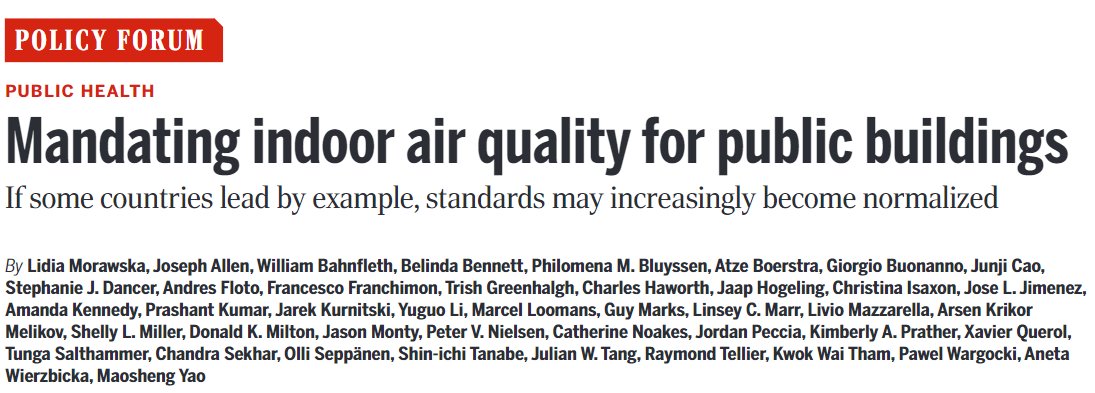1/ TIME FOR SOME AIRBORNE + DROPLET HISTORY
Now that @WHO and @CDCgov have finally accepted *after a year of denial and delays* that airborne transmission is a major mode for COVID-19, it is time to review the history to try to understand why this response was so poor.
Now that @WHO and @CDCgov have finally accepted *after a year of denial and delays* that airborne transmission is a major mode for COVID-19, it is time to review the history to try to understand why this response was so poor.
2/ Remember, the evidence is overwhelming that airborne transmission (1 to 1 in close proximity, and 1 to many in shared room air = superspreading) is the dominant mode of transmission.
https://twitter.com/jljcolorado/status/1383566908797059078
3/ And probably we are being charitable by saying only "dominant." Can't find any real evidence that airborne is not 99%. Airborne can explain all the epidemiological patterns, while large droplets and fomites can't, and they are pathetically lacking ev.
https://twitter.com/jljcolorado/status/1390497149574651906
4/ @zeynep published an outstanding article yesterday in the @nytimes where she explains the context, the implications, and some of the history.
I wanted to give some more historical detail, without the word limits that she faced in @nytimes.
nytimes.com/2021/05/07/opi…
I wanted to give some more historical detail, without the word limits that she faced in @nytimes.
nytimes.com/2021/05/07/opi…
5/ Why does this matter? bc we still face resistance. We have seen how @WHO and others do the changes too quietly, and they don't communicate how the mitigations need to change. And in many countries they report that mssg doesn't arrive, still focusing on disinfection + plexiglas
6/ We have written an article on history. Started by trying to figure out where 5 micron error for droplet / aerosol boundary came from, since physics tells us it is ~100 um. E.g. see this video of 50 micron particles, ain't falling to the ground quickly:
https://twitter.com/MicroLevitator/status/1283556047471378432
7/ But as we investigated the origins of the 5 micron error, we learned a lot more about the history of infectious disease transmission, which is the root of the resistance and delays of @WHO and @CDCgov. As we'll see, the creation of the @CDCgov is deeply embedded in the errors!
8/ Our preprint on the history can be read here. Written by @katierandall, @EThomasEwing, @linseymarr, Lydia Bourouiba and yours truly.
papers.ssrn.com/sol3/papers.cf…
papers.ssrn.com/sol3/papers.cf…
9/ We need to go back to the origins of theories about the transmission of diseases. Hippocrates (en.wikipedia.org/wiki/Hippocrat…) in ancient Greece proposed that diseases were transmitted through the air.
[I think doctors still do the Hippocratic Oath: en.wikipedia.org/wiki/Hippocrat…]
[I think doctors still do the Hippocratic Oath: en.wikipedia.org/wiki/Hippocrat…]
The Hippocratic text "On the Nature of Man" reads:
"Whenever many men are attacked by one disease at the same time, the cause should be assigned to that which is most common, and which we all use most. This it is which we breathe in."
loebclassics.com/view/hippocrat…
"Whenever many men are attacked by one disease at the same time, the cause should be assigned to that which is most common, and which we all use most. This it is which we breathe in."
loebclassics.com/view/hippocrat…
11/ Throughout much of human history, belief persisted that diseases were transported through the air. Coming from putrid matter, traveling long distances (e.g. a person infected by the flu in Boston could infect someone in UK)
This was miasma theory:
en.wikipedia.org/wiki/Miasma_th…
This was miasma theory:
en.wikipedia.org/wiki/Miasma_th…
12/ The idea of person-to-person transmission, which now seems obvious (e.g. we get COVID-19, the flu, or tuberculosis from another person) wasn't seriously considered till Italian physician Girolamo Fracastoro proposed it in 1546:
en.wikipedia.org/wiki/Girolamo_…
en.wikipedia.org/wiki/Girolamo_…
13/ The debate ensued for centuries between the miasmatists and the contagionists.
oyc.yale.edu/history/hist-2…
oyc.yale.edu/history/hist-2…
15/ CC was "a qualified way of rejecting application of term "contagious disease" for a particular infection. E.g. it could be stated that cholera, or typhus, was not contagious in a "healthy atmosphere", but might be contagious in an "impure atmosphere"
en.wikipedia.org/wiki/Contingen…
en.wikipedia.org/wiki/Contingen…
16/ Eerie how that applies to COVID-19. Highly contagious under some low ventilation conditions, much less so under well ventilated or outdoor conditions.
E.g. our preprint, where we reproduce indoor superspreading quantitatively with an airborne model:
E.g. our preprint, where we reproduce indoor superspreading quantitatively with an airborne model:
https://twitter.com/jljcolorado/status/1388948704384725000
17/ Florence Nightingale was a contingent contagionist.
During the Crimean war in the 1850s, she greatly reduced infection rates with social distance & ventilation.
en.wikipedia.org/wiki/Florence_…
During the Crimean war in the 1850s, she greatly reduced infection rates with social distance & ventilation.
en.wikipedia.org/wiki/Florence_…
18/ In 1854, there is a cholera epidemic in London. The public health established believed it to be caused by a miasma (bad air).
John Snow (en.wikipedia.org/wiki/John_Snow) shows that it is transmitted through water!
John Snow (en.wikipedia.org/wiki/John_Snow) shows that it is transmitted through water!
19/ The establishment didn't take it kindly, and refused to accept contaminated water as the explanation.
The Board of Health issued a report that said, “we see no reason to adopt this belief” and shrugged off Snow’s evidence as mere “suggestions.”
ph.ucla.edu/epi/snow/snowc…
The Board of Health issued a report that said, “we see no reason to adopt this belief” and shrugged off Snow’s evidence as mere “suggestions.”
ph.ucla.edu/epi/snow/snowc…
20/ @DFisman explained in this brilliant thread why the establishment was so keen on rejecting water as the source of cholera: they had a lot to lose, including their prestige by admitting they had been so wrong.
Snow was outsider & could afford fight
Snow was outsider & could afford fight
https://twitter.com/DFisman/status/1297676282755506177
21/ Ignaz Semmelweis was another pioneer of disease transmission (en.wikipedia.org/wiki/Ignaz_Sem…). In 1847, he figured out that handwashing greatly reduced deaths by childbed fever in a maternity clinic:
22/ These are some of Semmelweis' data (en.wikipedia.org/wiki/Ignaz_Sem…):
I'd call that pretty convincing and certainly worth a serious look.
I'd call that pretty convincing and certainly worth a serious look.

23/ But Semmelweis's was largely ignored, rejected, or ridiculed. He was dismissed from hospital for political reasons and harassed by medical community in Vienna, being eventually forced to move to Budapest.
After some years broke down, was interned & beated, died of infection
After some years broke down, was interned & beated, died of infection
24/ In the 2nd half of the 19th Century, Pasteur and Koch demonstrate the germ theory of disease:
en.wikipedia.org/wiki/Germ_theo…
en.wikipedia.org/wiki/Germ_theo…
25/ Germ theory is not accepted overnight: "By the end 1880s, miasma theory was struggling to compete. Viruses were initially discovered in the 1890s. Eventually, a "golden era" ensued, with identification of the actual organisms that cause many diseases.
en.wikipedia.org/wiki/Germ_theo…
en.wikipedia.org/wiki/Germ_theo…
26/ In the 1990s Carl Flugge in Germany sets out to disprove the then dominant theory, that tuberculosis is transmitted when the dry sputum of the sick goes back into the air.
en.wikipedia.org/wiki/Carl_Fl%C…
en.wikipedia.org/wiki/Carl_Fl%C…
27/ Flugge thought that it was not the dried secretions from the sick that went back to infect, but rather the fresh secretions were leading to infection before reaching the ground.
We explain this in paper (Lydia B. read the original papers in German)
papers.ssrn.com/sol3/papers.cf…
We explain this in paper (Lydia B. read the original papers in German)
papers.ssrn.com/sol3/papers.cf…
28/ Although it has been attributed to him (e.g. erroneously in Wikipedia: en.wikipedia.org/wiki/Carl_Fl%C…), he didn't push "Flugge's droplets" that fell to ground.
They waited 5 hours for droplets AND aerosols to settle from the air!!
They waited 5 hours for droplets AND aerosols to settle from the air!!
29/ In 1905 a speaker at the pulpit of the expansive UK House of Commons gargled with a broth culture of B. prodigiosus before reciting Shakespeare
passages in a loud voice to the empty room...
passages in a loud voice to the empty room...
30/ ... although growth colonies were more numerous in
plates near the speaker, cultures were apparent on plates over 21 m away.
play.google.com/books/reader?i…
plates near the speaker, cultures were apparent on plates over 21 m away.
play.google.com/books/reader?i…
31/ So we get to the critical point in the history, the work of prominent American epidemiologist Charles V. Chapin. He was very successful, in 1927 the President of American Public Health Association.
en.wikipedia.org/wiki/Charles_V…
en.wikipedia.org/wiki/Charles_V…
32/ Chapin was enormously influential for along time, till today. He was described in 1967 as "the greatest American epidemiologist" by Alexander Langmuir, the first a long-time director (1949-1969) of the epidemiology branch of the @CDCgov
Sorry, have to take a break to take kid to soccer. Just a I was getting to the most interesting part of the history. I'll continue in a couple of hours
34/ OK, back from soccer. Kid's team lost 2-8 and he and his best friend got hit on the face with the ball (they are 7), but they had a great time.
Let's redo the last tweet on Chapin since I made some mistakes by hurrying.
Also typo on tweet #26, Flugge worked in 1890s
Let's redo the last tweet on Chapin since I made some mistakes by hurrying.
Also typo on tweet #26, Flugge worked in 1890s
35/ Chapin was enormously influential for a long time, (till today really). He was described in 1967 as "the greatest American epidemiologist" by Alexander Langmuir (academic.oup.com/aje/article/14…), the first and long-time director (1949-1969) of the epidemiology branch of the @CDCgov
36/ Chapin is working when miasma theory of phantasmagorical disease transmission through the air is still in the public's mind. Not so long after germ theory has been accepted.
It is a fluid time. He studies the evidence of transmission of different diseases.
It is a fluid time. He studies the evidence of transmission of different diseases.
37/ In 1910 he published his seminal book "The Sources and Modes of Infection."
Free on the web, and extraordinarily interesting for anyone who digs this history.
play.google.com/store/books/de…
Free on the web, and extraordinarily interesting for anyone who digs this history.
play.google.com/store/books/de…
38/ Chapin conceptualized "contact infection". Germs don't come from the environment, they come from other people through direct contact or close proximity.
Starts the book by arguing against the first idea:
Starts the book by arguing against the first idea:

39/ In the book he argues that since germs begin to die or lose their virulence outside of the body, the closer we are to others, the greater the chance of infection.
"Contact infection is more important than by fomites or by air"
"Contact infection is more important than by fomites or by air"

40/ There are many opportunities for "transfer or secretions" between people during close contact, including from asymptomatic cases.
Like "typhoid Mary," (en.wikipedia.org/wiki/Mary_Mall…) an asymptomatic cook who infected 53 people with typhoid fever in 1907.
Chapin of course aware.
Like "typhoid Mary," (en.wikipedia.org/wiki/Mary_Mall…) an asymptomatic cook who infected 53 people with typhoid fever in 1907.
Chapin of course aware.
41/ Chapin believes that contact infection is the main mode of transmission of many diseases. But like any new theory, he encounters resistance: "I have sometimes been told I lay too much emphasis on contact infection."
"Until recently very little attention has been paid to it"
"Until recently very little attention has been paid to it"

42/ Chapin also reviews the possibility of airborne infection. As he admits at the end of that chapter, the belief on airborne infection is the main obstacle he is encountering to promote his ideas of the importance of contact infection: 
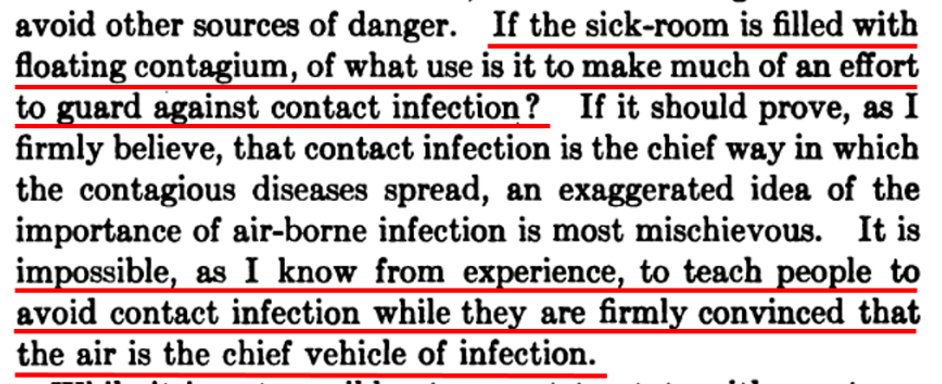
43/ Chapin is aware of the work of Flugge (tweets 26-28). Tiny droplets that can be seen in the proper light. That on a bad cough can reach 9 meters. 

44/ Chapin is also aware of the work of Flugge and at the UK the House of Commons showing transport of germs for considerable distances and floating for hours (tweets 28-30). 

45/ C. concludes that the evidence for transmission through the air is overall weak, and that contact and spray-borne infection is a better explanation of the observed patterns.
He was especially fighting airborne transmission over v. long distances, nearly impossible to avoid
He was especially fighting airborne transmission over v. long distances, nearly impossible to avoid

46/ And we get to the key point: there is not a lot of evidence of airborne, & it is getting on the way of contact.
Therefore "we are warranted in discarding [airborne]. It will be a great relief to most persons to be freed from the specter of infected air... since Hippocrates"
Therefore "we are warranted in discarding [airborne]. It will be a great relief to most persons to be freed from the specter of infected air... since Hippocrates"
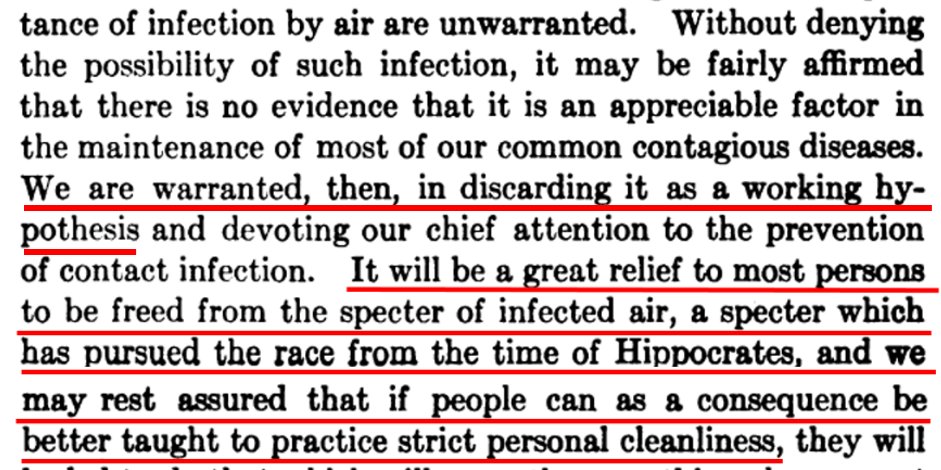
47/ To learn more about Chapin's views, this short book is the transcript of a talk he gave at Harvard in 1917:
books.google.com/books?id=vS47A…
books.google.com/books?id=vS47A…
48/ The 1918 "Spanish Flu" happens the next year. There is evidence that ventilation and outdoor air work, that point to airborne transmission.
https://twitter.com/Orla_Hegarty/status/1373212120171610120
49/ Still, Chapin's ideas are widely accepted over the next 2 decades and become firmly established.
In the 1930s, William Wells (Harvard Prof.) & wife Milfred Wells start applying more modern methods to the investigation of airborne transmission.
In particular TB & measles.
In the 1930s, William Wells (Harvard Prof.) & wife Milfred Wells start applying more modern methods to the investigation of airborne transmission.
In particular TB & measles.
50/ Wells is the first person to study what is the size of sprayborne droplets vs. airborne aerosols.
Conceptualizes it as sprayborne droplets fall before they dry, while aerosols dry before they fall (thus "droplet nuclei".
academic.oup.com/aje/article-ab…
Conceptualizes it as sprayborne droplets fall before they dry, while aerosols dry before they fall (thus "droplet nuclei".
academic.oup.com/aje/article-ab…
51/ Figures out that droplets are larger than ~100 microns, and aerosols smaller.
"A raindrop 2 mm in diameter can fall miles without completely evaporating under conditions which would cause a 0.2 mm droplet to evaporate before it had fallen from the height of a man"
"A raindrop 2 mm in diameter can fall miles without completely evaporating under conditions which would cause a 0.2 mm droplet to evaporate before it had fallen from the height of a man"

52/ The Wells encounter a lot of resistance. They are accused of "trying to bring back miasmas"
en.wikipedia.org/wiki/William_F…
en.wikipedia.org/wiki/William_F…
53/ Chapin had fought for his ideas. He knew of course of the difficulties that Semmelweis or Snow had had to get their theories accepted.
But he was better positioned & was spectacularly successful. Ease of infection in close proximity was understood as PROOF of spray droplets
But he was better positioned & was spectacularly successful. Ease of infection in close proximity was understood as PROOF of spray droplets
54/ Measles was thought to be a droplet fomite disease. At the time of Wells, and as late as 1985, because of ease of transmission in close proximity ( == sprayborne droplets per Chapin) and cases of lack of infection with shared air.
Wells thinks it is airborne.
Wells thinks it is airborne.

55/ Wells has some initial success showing that UV lights installed in the ceiling of classrooms greatly reduced measles infection.
ajph.aphapublications.org/doi/10.2105/AJ…
ajph.aphapublications.org/doi/10.2105/AJ…
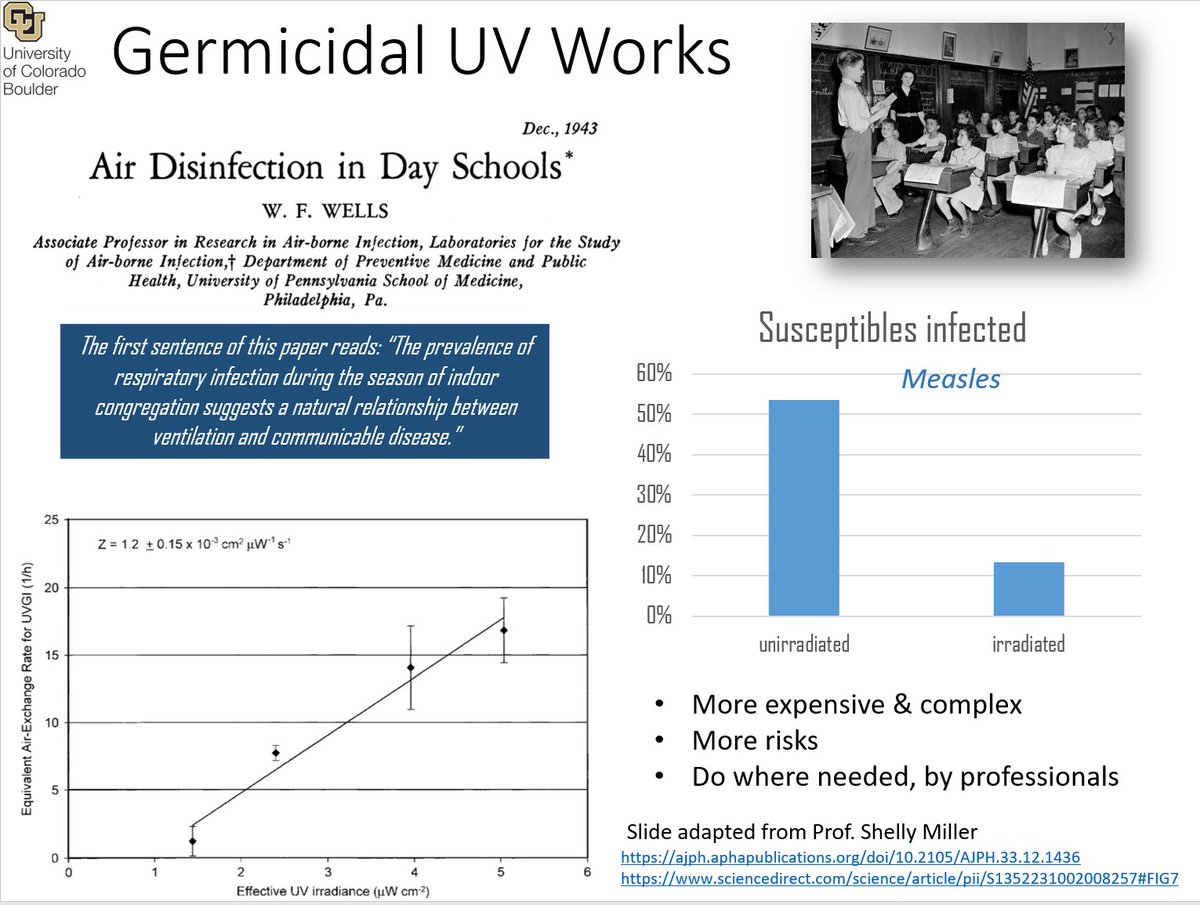
56/ However, subsequent attempts give mixed results.
In retrospect, clear why:
- In school where UV worked the kids where only together indoors in the school, not otherwise
- In later schools they shared other indoor spaces for hours, such as school buses. Got infected there.
In retrospect, clear why:
- In school where UV worked the kids where only together indoors in the school, not otherwise
- In later schools they shared other indoor spaces for hours, such as school buses. Got infected there.
57/ In the 1945 article in the predecessor journal of @ScienceMagazine, Wells laments how our societies have invested and been successful on eliminating infections through drinking water and through food.
But air infection is denied, so no action taken
ajph.aphapublications.org/doi/10.2105/AJ…
But air infection is denied, so no action taken
ajph.aphapublications.org/doi/10.2105/AJ…
58/ In 1951, Alexander Langmuir (first and longtime director of epidemiology branch of @CDCgov) states:
"It remains to be proved that airborne infection is an important mode of spread of naturally occurring disease”
ncbi.nlm.nih.gov/pmc/articles/P…
"It remains to be proved that airborne infection is an important mode of spread of naturally occurring disease”
ncbi.nlm.nih.gov/pmc/articles/P…
59/ However, Langmuir has renewed interest on the physics of airborne infection, because of biological warfare. Natural diseases don't seem to be airborne, but Langmuir reaches the conclusion that weapons of airborne disease can be created.
papers.ssrn.com/sol3/papers.cf…
papers.ssrn.com/sol3/papers.cf…

60/ Langmuir has a key problem when trying to investigate airborne infection.
He views the world through the lens of Chapin's theories. He had called Chapin the greatest American epidemiologist, and as late as 1980 Chapin's views were still dominant:
academic.oup.com/aje/article/14…
He views the world through the lens of Chapin's theories. He had called Chapin the greatest American epidemiologist, and as late as 1980 Chapin's views were still dominant:
academic.oup.com/aje/article/14…

61/ It is apparent reading this article on Langmuir and his investigation of airborne transmission that he had the wrong Chapin-influenced mental model.
They equated transmission in close proximity with droplets only.
academic.oup.com/aje/article/14…
They equated transmission in close proximity with droplets only.
academic.oup.com/aje/article/14…
62/ And they ignored the concept of dilution!! They assumed that airborne infection would STAY THE SAME if distance increased.
academic.oup.com/aje/article/14…
academic.oup.com/aje/article/14…
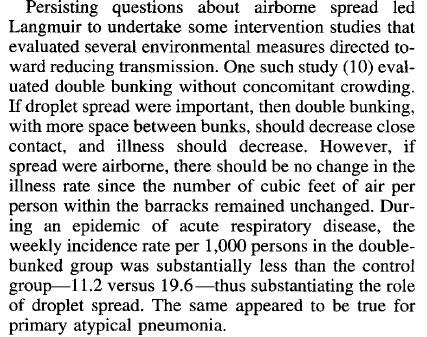
63/ But that is not how the world works. Distance reduces droplets, but it also reduces how much exhaled air from others is inhaled (think cigarette smoke).
I have this image as my Twitter banner because @WHO & @CDCgov have been making this very error TILL THIS WEEK!!
I have this image as my Twitter banner because @WHO & @CDCgov have been making this very error TILL THIS WEEK!!

64/ Despite all the resistance, the Wellses, Robert Riley, and Cretyl Mills succeed in demonstrating aiborne transmission of tuberculosis in 1962, from people to guinea pigs.
pubmed.ncbi.nlm.nih.gov/14492300/
pubmed.ncbi.nlm.nih.gov/14492300/
65/ They have 150 guinea pigs in cages, and the air from a ward with TB patients is channeled to them. 3 GP per month get infected. None get infected in a control group where the only difference is the air is UV irradiated, killing the TB bacterium.
pubmed.ncbi.nlm.nih.gov/14492300/
pubmed.ncbi.nlm.nih.gov/14492300/
66/ That's what it took to accept TB was airborne.
Notable that there are similar experiments for COVID-19 with ferrets and hamsters, but they are routinely dismissed as irrelevant by the dropletologists.
Notable that there are similar experiments for COVID-19 with ferrets and hamsters, but they are routinely dismissed as irrelevant by the dropletologists.
https://twitter.com/jljcolorado/status/1383575679820652546
67/ Airborne transmission of smallpox is accepted in 1971. There is an obvious case of long-distance transmission in a hospital in Germany.
https://twitter.com/jljcolorado/status/1383571920910635010
68/ The article on the German smallpox outbreak notes the ongoing thinking: "The only remaining route of transmission considered reasonable was airborne spread
of a virus-containing aerosol, ***a possibility against which all of the investigators were initially prejudiced***."
of a virus-containing aerosol, ***a possibility against which all of the investigators were initially prejudiced***."

69/ Smallpox airborne transmission accepted bc so obvious, even those prejudiced against it can't deny it!
But it is still described as an unusual event, ¨a unique exception¨
Smallpox still thought droplet-fomite, accepting as little airb. as possible
academic.oup.com/aje/article/14…
But it is still described as an unusual event, ¨a unique exception¨
Smallpox still thought droplet-fomite, accepting as little airb. as possible
academic.oup.com/aje/article/14…

70/ The same is done today by droplet-proponents, when discussing obvious cases of long-distance COVID-19 transmission (e.g 15 m behind someone in a church, with video showing no contact and genomic match). "That's unusual, but COVID is droplet otherwise"
https://twitter.com/jljcolorado/status/1383570830530007045
71/ Eventually measles is also accepted as airborne after about 75 YEARS of calling it droplet / fomite. Bc of undeniable superspreading events
Makes me chuckle when droplet proponents suggest it'd be obvious COVID was airborne if it was like measles. It was quick last time...
Makes me chuckle when droplet proponents suggest it'd be obvious COVID was airborne if it was like measles. It was quick last time...
72/ This is one of the articles on measles superspreading:
pediatrics.aappublications.org/content/75/4/6…
pediatrics.aappublications.org/content/75/4/6…
73/ Eventually chickenpox is also accepted as airborne, also based on superspreading (nejm.org/doi/full/10.10…)
Both measles and chickenpox are much more contagious than COVID on average. (Although COVID superspreading is not that far from measles)
Both measles and chickenpox are much more contagious than COVID on average. (Although COVID superspreading is not that far from measles)
74/ Interestingly, despite all the resistance to accept TB, measles, and chickenpox as airborne for decades and decades, they were accepted with much less evidence than we have today for COVID-19 being airborne.
https://twitter.com/jljcolorado/status/1383586839806693379
75/ OK, have to take another break for dinner. Phew, this is the longest thread I have written. But I think it is worth putting the effort into it, because I am convinced history set us up for the huge error of denying that COVID-19 is an airborne disease. Will finish in few hrs
76/ So before COVID-19, TB (less contagious but undeniable) and measles / chickenpox (very highly contagious, obvious superspreading) were widely accepted as airborne
Turns out there is evidence for airborne transmission for a lot of respiratory diseases, but not widely accepted
Turns out there is evidence for airborne transmission for a lot of respiratory diseases, but not widely accepted
77/ E.g. the flu, very important for its pandemic potential. Superspreading in plane:
"A plane w/ 54 persons aboard was delayed on the ground for 3 hours without ventilation. Within 72 hours, 72% of passengers got the flu."
academic.oup.com/aje/article-ab…
"A plane w/ 54 persons aboard was delayed on the ground for 3 hours without ventilation. Within 72 hours, 72% of passengers got the flu."
academic.oup.com/aje/article-ab…

78/ Infective flu virus has been captured from exhaled breath:
pnas.org/content/115/5/…
Yet the flu is solidly considered a droplet / fomite disease.
pnas.org/content/115/5/…
Yet the flu is solidly considered a droplet / fomite disease.
79/ could go on & on. I recommend following @jmcrookston and reading his older threads for a look at the historical literature for many diseases.
It seems that airborne was pretty obvious all along for many diseases, but was rejected "as much as possible" (as smallpox Tw 68-69)
It seems that airborne was pretty obvious all along for many diseases, but was rejected "as much as possible" (as smallpox Tw 68-69)
80/ Within this wider dominance of the droplet / fomite theory, an error slips in at some point.
- Wells showed that aerosols are < 100 microns, to fall to the ground near person (tweet #51)
- Langmuir knew that to get deep into lung, need very small aerosols < 5 um (tweet 59)
- Wells showed that aerosols are < 100 microns, to fall to the ground near person (tweet #51)
- Langmuir knew that to get deep into lung, need very small aerosols < 5 um (tweet 59)
81/ But somehow an error is introduced confusing the 2: @WHO and @CDCgov guidelines start saying that particles smaller than 5 microns fall to the ground.
Do this for decades, e.g. the LATEST @WHO Scientific Brief on COVID-19 transmission! (no reference)
who.int/publications/i…
Do this for decades, e.g. the LATEST @WHO Scientific Brief on COVID-19 transmission! (no reference)
who.int/publications/i…
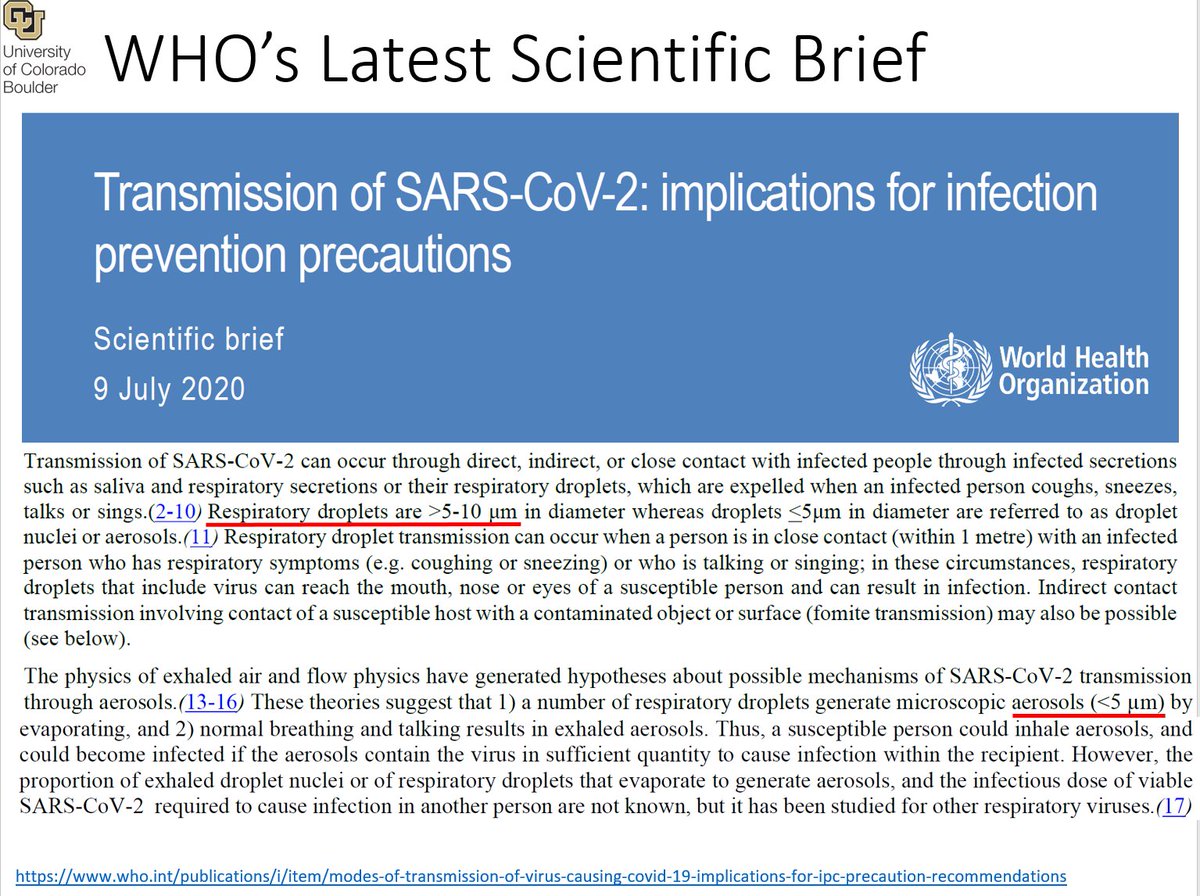
82/ We followed the references, and they lead nowhere. No primary study ever stated that particles smaller than 5 microns fall to the ground within 1-2 m of a person.
papers.ssrn.com/sol3/papers.cf…
papers.ssrn.com/sol3/papers.cf…

83/ What seems to have happened:
- Tuberculosis was the main airborne infection of concern
- TB can ONLY infect if aerosols reach alveoli (< 5 microns)
- Someone confused reaching the deep lung (< 5 microns) w/ falling to the ground within 1-2 m (>100 microns)
- Tuberculosis was the main airborne infection of concern
- TB can ONLY infect if aerosols reach alveoli (< 5 microns)
- Someone confused reaching the deep lung (< 5 microns) w/ falling to the ground within 1-2 m (>100 microns)
84/ @CDCgov seems to have realized this error in their 2007 Infection Control Guidelines
Yet this never became common knowledge (e.g. not to the world-renowed @WHO experts that wrote its COVID-19 transmission scientific briefing)
cdc.gov/infectioncontr…
Yet this never became common knowledge (e.g. not to the world-renowed @WHO experts that wrote its COVID-19 transmission scientific briefing)
cdc.gov/infectioncontr…

85/ Many people say they don't care about microns.
But the key is the disregard of aerosol science that this reveals: for DECADES, an error was repeated over and over, despite the right answer being on the @CDCgov web page (occ. med. branch):
cdc.gov/niosh/topics/a…
But the key is the disregard of aerosol science that this reveals: for DECADES, an error was repeated over and over, despite the right answer being on the @CDCgov web page (occ. med. branch):
cdc.gov/niosh/topics/a…
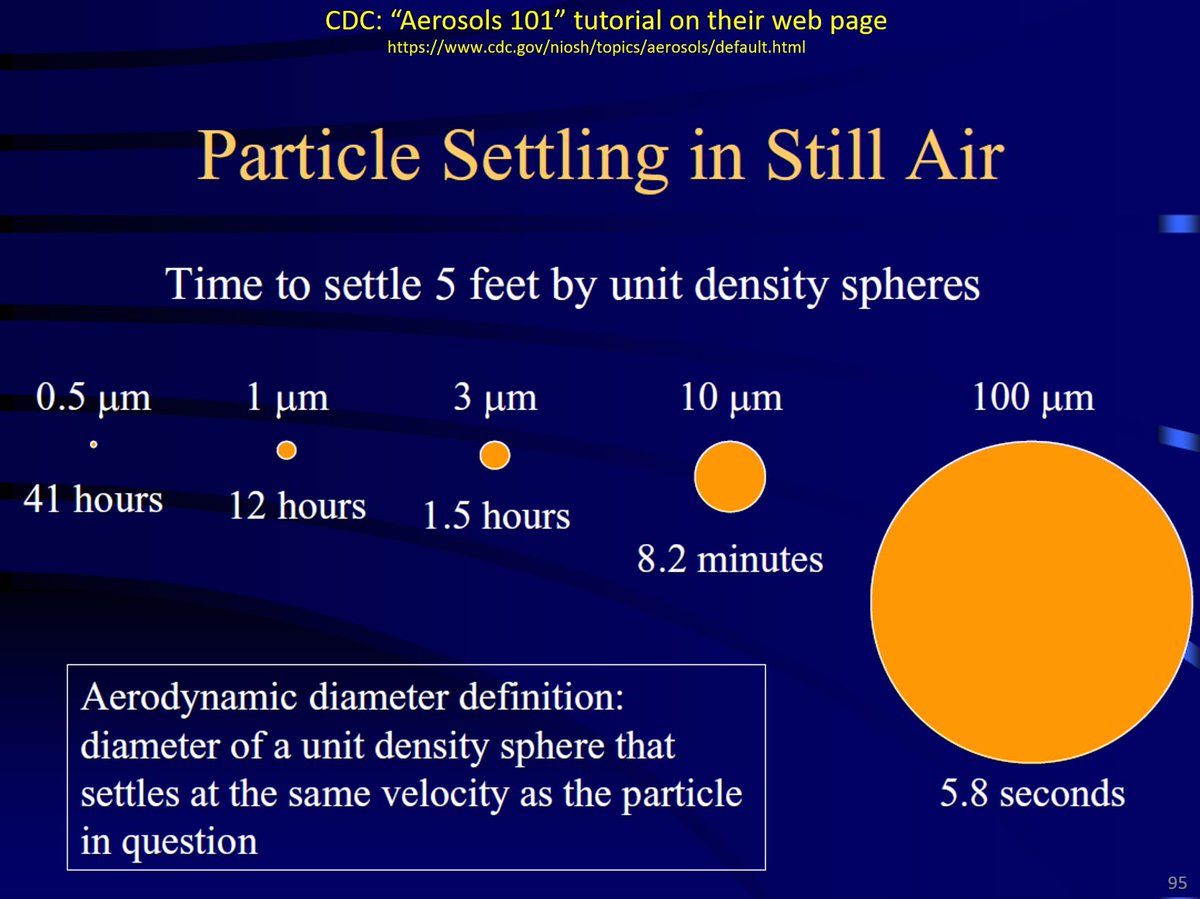
86/ And the physics of the ~100 micron aerosol / droplet was re-examined and published again, e.g. by Prof. Yuguo Li, prominent expert in this field:
He is in @WHO committees, but droplet experts didn't listen.
onlinelibrary.wiley.com/doi/10.1111/j.…
He is in @WHO committees, but droplet experts didn't listen.
onlinelibrary.wiley.com/doi/10.1111/j.…

87/ So what the 5 micron error really reveals is a key sociological aspect. Despite droplet infection being a hypothesis without much evidence, it was SO dominant that the experts didn't even bother with the details, and ignored aerosol experts and their work.
88/ In reality, droplet infection is a house of cards.
From Y. Li's review of the scientific literature: It has NEVER been demonstrated directly for ANY disease in the history of medicine!
[If you have a paper that proves otherwise, pls send it to me]
sciencedirect.com/science/articl…
From Y. Li's review of the scientific literature: It has NEVER been demonstrated directly for ANY disease in the history of medicine!
[If you have a paper that proves otherwise, pls send it to me]
sciencedirect.com/science/articl…

89/ Ease of infection in close proximity could be explained by droplets, but can also be explained by aerosols.
doi.org/10.1016/j.jhin…
doi.org/10.1016/j.jhin…
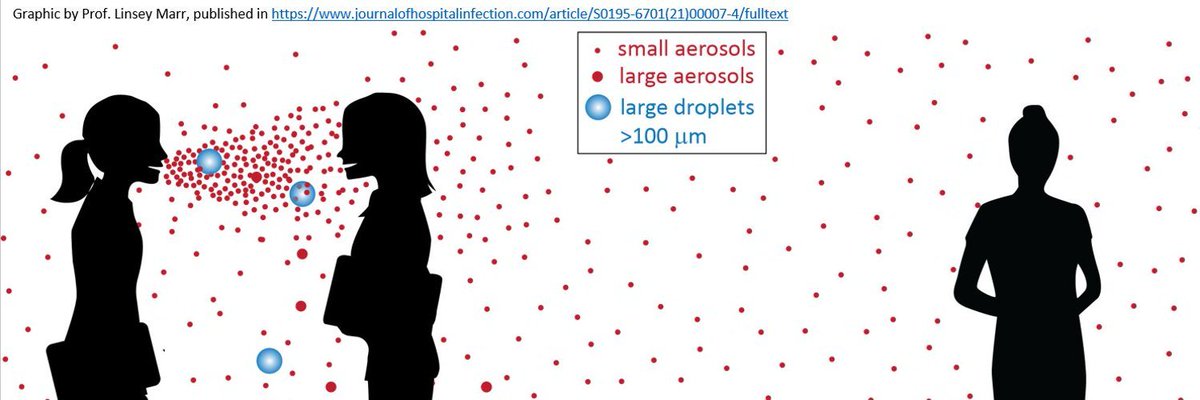
90/ Lack of infection w/ shared air can be explained by some people not exhaling infective virus. Shown for SARS-CoV-2 (slide, )
As for measles for 7 decades, droplet proponents have a HIDDEN assumption: everyone infected sheds lots of infective virus
doi.org/10.1093/cid/ci…
As for measles for 7 decades, droplet proponents have a HIDDEN assumption: everyone infected sheds lots of infective virus
doi.org/10.1093/cid/ci…

91/ We explain other myths about airborne transmission that have no basis, yet they are constantly repeated by e.g. major @WHO advisors and Public Health authorities around the world to justify droplet transmission of COVID and deny airborne transmission.
doi.org/10.1016/j.jhin…
doi.org/10.1016/j.jhin…
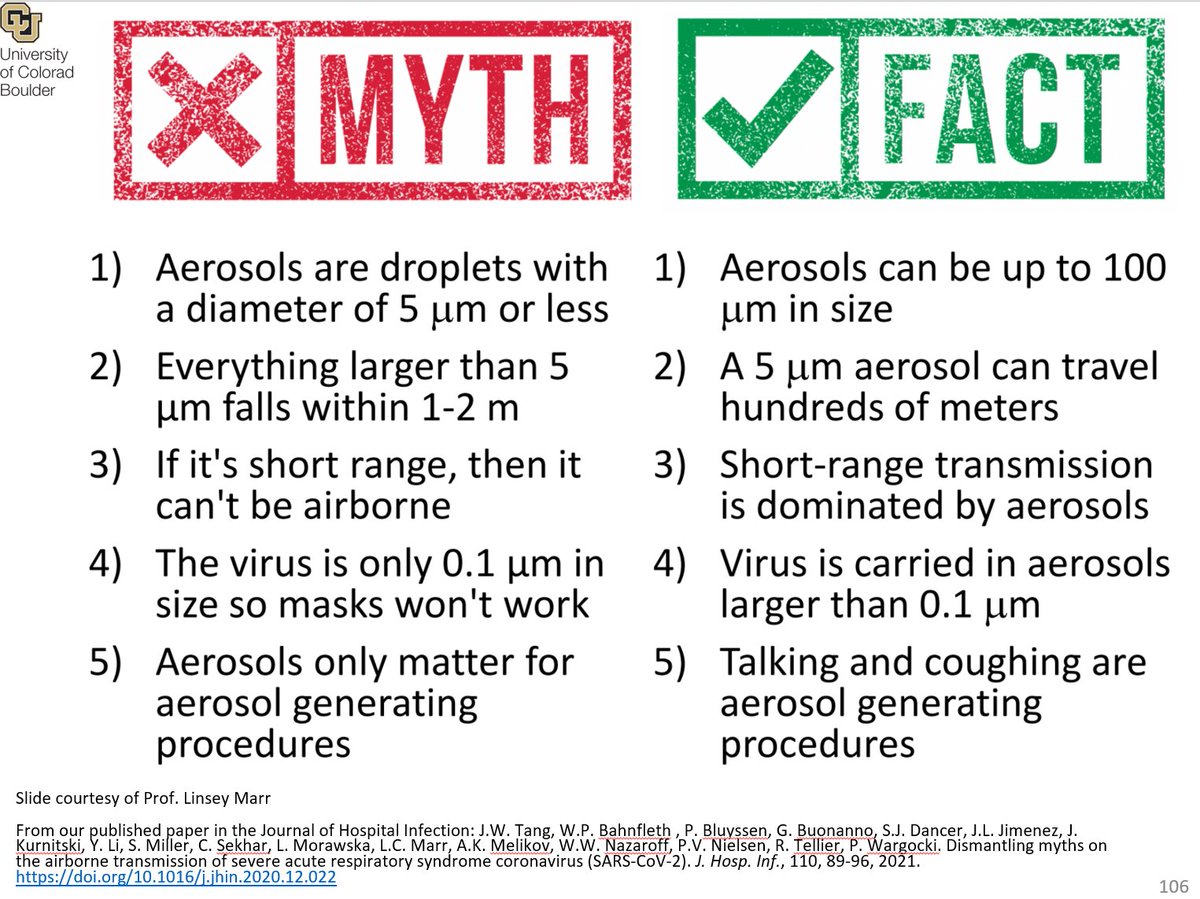
92/ During the last many decades, with antibiotics, vaccines, and no huge pandemics, these details of transmission had not been a priority. Droplet experts were in control of all key institutions, could ignore few airborne proponents.
93/ E.g. colleagues mention that often they would write a research proposal to fund a study of airborne transmission.
And the anonymous peer-reviews would come back saying "airborne transmission is not important, therefore we shouldn't waste funding on this."
And the anonymous peer-reviews would come back saying "airborne transmission is not important, therefore we shouldn't waste funding on this."
94/ When I started working on this in Feb. 2020, it seemed that the airborne transmission experts were VERY shy, compared to the significant evidence in favor of airborne.
With time I realized they had PTSD from being ignored and ridiculed over decades!
With time I realized they had PTSD from being ignored and ridiculed over decades!
https://twitter.com/linseymarr/status/1390770560653737988
95/ So it is with this background that @WHO confidently declared on 28-March-2020 that "FACT: COVID is NOT AIRBORNE".
And that saying it was airborne was MISINFORMATION, that we need to help @WHO fight!
And that saying it was airborne was MISINFORMATION, that we need to help @WHO fight!
https://twitter.com/who/status/1243972193169616898?lang=en
96/ Lidia Morawska organized an international group of scientists to talk to @WHO, which we did on 3-Apr-2020.
I found that meeting shocking, couldn't get my head around why the @WHO experts were SOOOO dismissive of airborne.
I found that meeting shocking, couldn't get my head around why the @WHO experts were SOOOO dismissive of airborne.
97/ @Don_Milton said the super-strong anti-airborne prejudice was due to history and this Chapin fellow.
I was very perplexed. But I started reading on the history and talking to people. And I learned in the last year what I have told you today.
I was very perplexed. But I started reading on the history and talking to people. And I learned in the last year what I have told you today.
98/ So yours truly and 100s of scientists have spent the last year working on this, as exemplified by this depiction: 
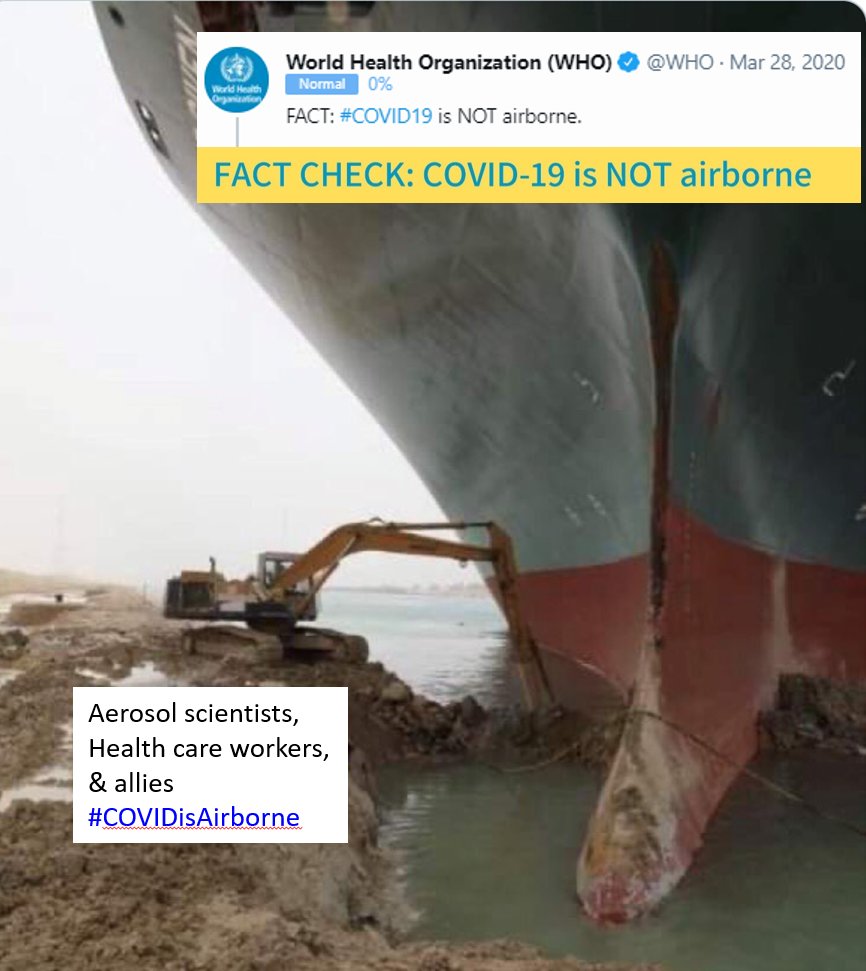
99/ Cleary droplet theory is sinking, unable to explain the observations. Still its proponents are resorting to the equivalent of epicycles, trying to save a failing theory by adding patches like "situational airborne"
But Thomas Kuhn is coming for them w/ a paradigm shift...
But Thomas Kuhn is coming for them w/ a paradigm shift...
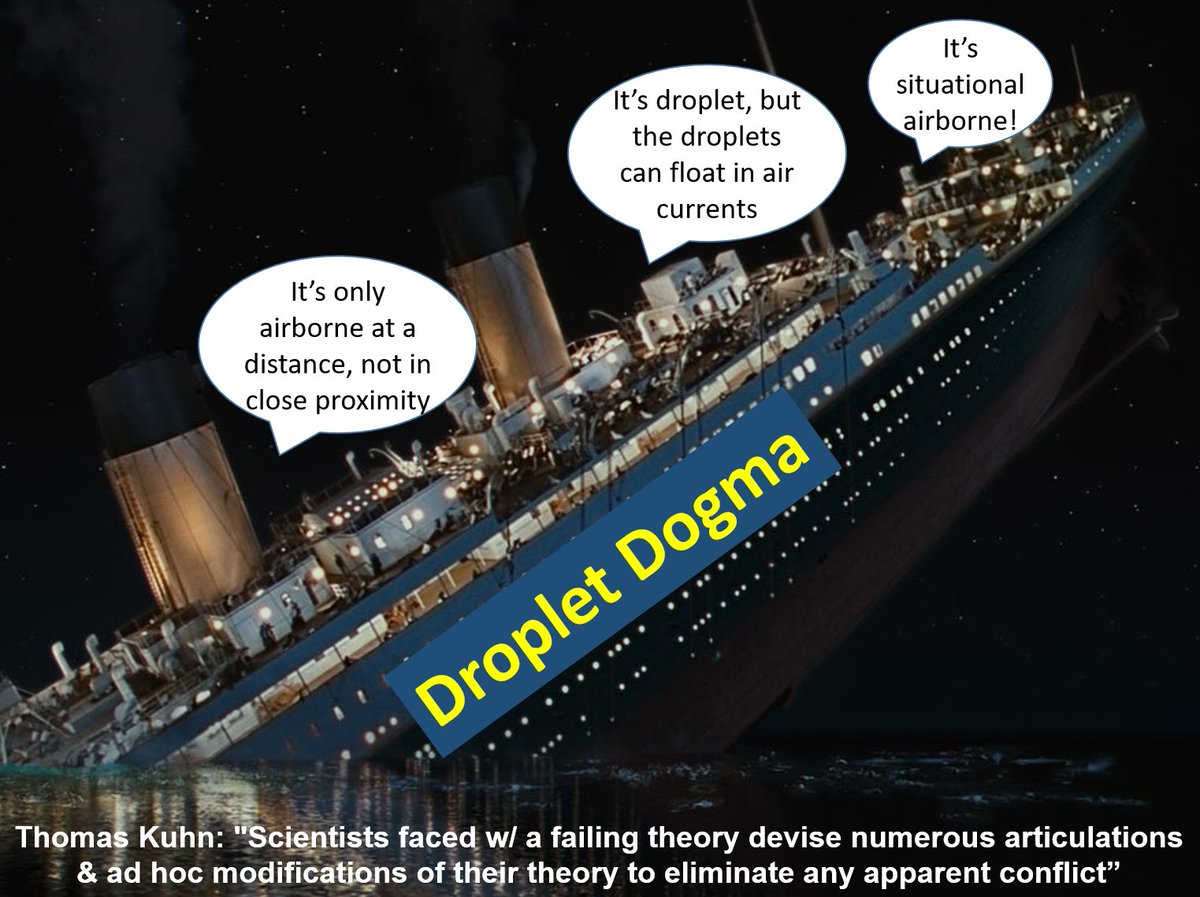
100/ Our work is not done. It is critical to tell the world loud and clear that this virus is airborne, 1-on-1 in close proximity and 1-to-several in shared room air.
The message, and the changes in mitigations, have not arrived to many countries, or not clearly.
The message, and the changes in mitigations, have not arrived to many countries, or not clearly.
101/ OK, I'll leave it there for today. But if you made it to here, please answer this question. Should I do something with this thread?
102/ For an automatic translation, see this link (change "Spanish" at the top of the page for the language of interest to you:
…5y-threadreaderapp-com.translate.goog/thread/1391111…
HT @DrZoeHyde
…5y-threadreaderapp-com.translate.goog/thread/1391111…
HT @DrZoeHyde
103/ PS: I realize that in tweet #57 I linked the wrong paper of Wells.
Below is the start of the paper, where he laments how ventilation has not kept up with disinfection of water and food, due to Chapin's denial of airborne transmission.
jstor.org/stable/18316?s…
Below is the start of the paper, where he laments how ventilation has not kept up with disinfection of water and food, due to Chapin's denial of airborne transmission.
jstor.org/stable/18316?s…
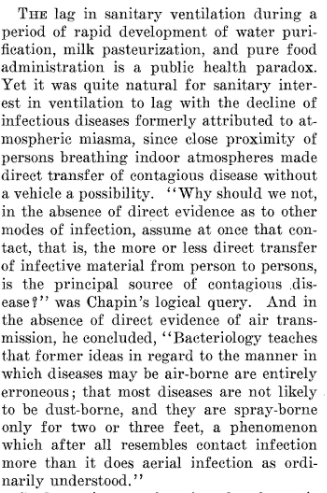
104/ PS2: anyone who liked this thread should really enjoy this article by @MeganMolteni in @WIRED where she explores the recent history around the 5 micron error and the detective work of @katierandall @linseymarr @EThomasEwing Lydia Bourouiba et al.
https://twitter.com/linseymarr/status/1392849845900218372
• • •
Missing some Tweet in this thread? You can try to
force a refresh




